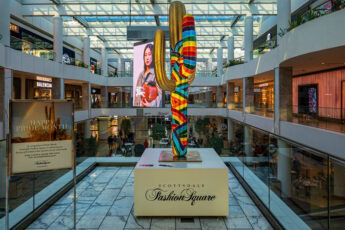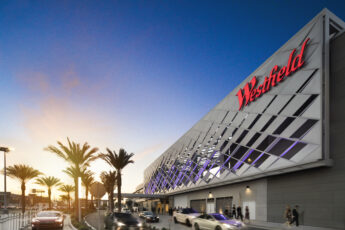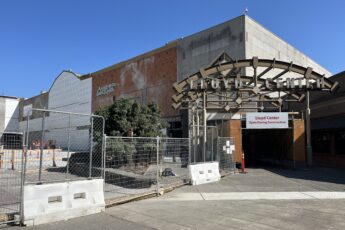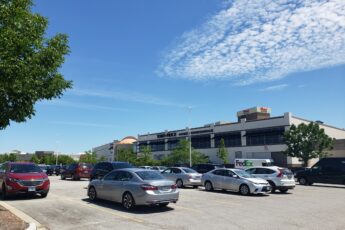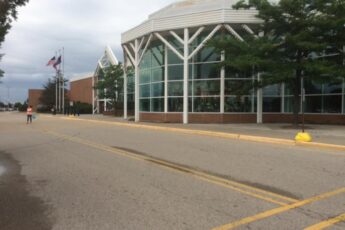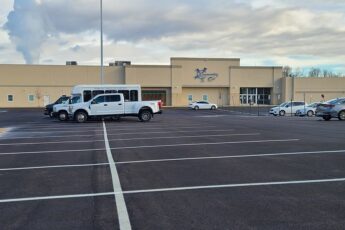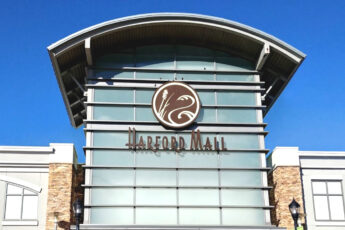Galleria at Tyler: Origins and Planning (1965-1970)
In 1965, two mall developments competed for Riverside's attention. Hunter Penn proposed a 66-acre site at Magnolia Avenue and Tyler Street. Meanwhile, Marcus W. Meairs Co. proposed a 113-acre site at Magnolia Avenue and Monroe Street.
Both attracted interest from major department stores. May Co. and The Broadway favored the Hunter Penn site, while JCPenney and Buffum's leaned towards the Meairs site.
Retail experts agreed Riverside couldn't support both proposals. In mid-1966, The Broadway and May Co. bought out Hunter Penn's interest in both the Montclair and Riverside sites. They paid $2 million for the Tyler property, averaging $33,000 per acre.
Initial site preparation began in early 1968. By February 1969, with developer Ernest W. Hahn on board, plans were public.
They announced a $45 million regional shopping center at Tyler and Magnolia in Riverside. Participants included Broadway-Hale Stores Inc., May Co., JCPenney Co., and Ernest W. Hahn.
Construction started in October 1969, and the Tyler Mall opened on October 12, 1970. The mall featured The Broadway, JCPenney, and Woolworth. Initially, it had 68 stores, which soon grew to 85.
The Broadway building, designed by Charles Luckman & Associates, stood out with its unique cantilevered design. Jim Van Schaak designed the interior, which won "Department Store of the Year" in the national "Store Interior Design" competition.
The mall's initial offerings included two restaurants, Howard Johnson's and Farrell's Ice Cream Parlour, and two auto centers for JCPenney and Broadway. A free-standing United California Bank and a gas station also operated on the property.
The Tyler Mall, twice as large as the older Riverside Plaza, quickly became a key shopping destination in Riverside.
Early Years and First Expansion (1970s-1980s)
Throughout the 1970s and 1980s, the Tyler Mall performed well. In 1973, May Co. opened a new store at the south end, introducing a new retail concept with a restaurant and cocktail lounge. This addition cemented Tyler Mall's status as a major shopping hub.
Despite its success, the mall lacked an upscale department store. Buffum's showed interest in the late 1960s, and Bullock's considered a store in 1980, but economic conditions and mergers kept them from committing. Meanwhile, the mall continued to attract shoppers with its varied retail offerings and convenient location.
In 1987, Seattle-based Nordstrom began showing interest in opening a store at the Tyler Mall. This interest came after the successful opening of a Nordstrom at Montclair Plaza.
However, shoppers in Riverside had to wait a few more years due to obstacles threatening the proposed expansion. The anticipation of Nordstrom's arrival highlighted the mall's ongoing evolution and growth.
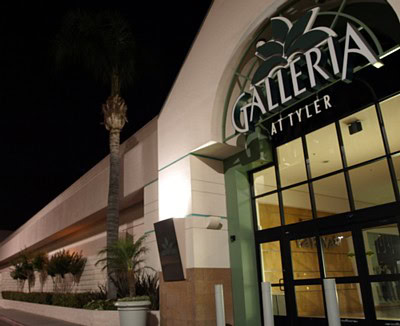
Rebranding and Major Renovations (1990s)
In 1991, the Tyler Mall underwent a major transformation and became the Galleria at Tyler. This rebranding marked a new era for the mall. They added a second story, making it more spacious and attractive for both shoppers and retailers.
The introduction of Nordstrom as a new anchor store brought an upscale element that had been missing. Nordstrom's arrival changed the mall's atmosphere and drew in a different crowd.
The Galleria at Tyler also saw architectural updates. The modern design and expanded space allowed for more retail options and a better shopping experience. Popular retailers like The Disney Store and Eddie Bauer were included. These additions catered to a wide range of shoppers, from families to fashion enthusiasts.
The 1990s renovations didn't stop at physical changes. They updated the tenant mix, bringing in stores like The Gap, Banana Republic, and Abercrombie & Fitch. The mall's food court got a facelift, offering more dining choices. The new look and feel of the Galleria at Tyler set the stage for its future success.
Continued Growth and Modernization (2000s)
The Galleria at Tyler kept evolving in the 2000s. Between 2006 and 2007, the mall focused on expanding its dining and entertainment options.
The Cheesecake Factory and P.F. Chang's opened in 2006, followed by Yard House in 2007. These restaurants attracted more visitors and offered diverse dining experiences.
AMC Theatres and Robbins Brothers joined the mall during this period. AMC brought a state-of-the-art movie-going experience, while Robbins Brothers added a unique jewelry shopping option. These additions made the Galleria at Tyler a more complete destination for entertainment and shopping.
Throughout the 2000s, the mall continued to update its retail offerings. Stores like H&M and Forever 21 opened, appealing to younger shoppers.
The Galleria at Tyler also embraced seasonal and pop-up shops, keeping the shopping experience fresh and exciting. This approach kept the mall relevant and engaging for a broad audience.
Challenges and Adaptations (2010s)
The 2010s brought challenges to the Galleria at Tyler. In 2015, a dramatic event occurred when three men used sledgehammers and axes to rob Ben Bridge Jeweler. This incident, just days after the San Bernardino attack, caused a panic.
Shoppers mistook the sound of breaking glass for gunshots, leading to a large police response. Thankfully, authorities resolved the situation quickly, but it reminded everyone of the vulnerabilities even bustling malls face.
In 2020, the COVID-19 pandemic hit retailers hard. Nordstrom, a major anchor, announced it would close its Galleria at Tyler location. This closure was part of a broader strategy to cut back amid economic uncertainty.
Losing Nordstrom was a blow, but the mall adapted. By August 2022, Furniture City replaced Nordstrom's space, filling the void left by the upscale retailer.
Despite these challenges, the mall continued to attract visitors. Stores and restaurants adapted by enhancing safety measures and promoting online shopping options. The Galleria at Tyler proved its resilience, navigating through tough times while still providing a place for the community to shop and gather.
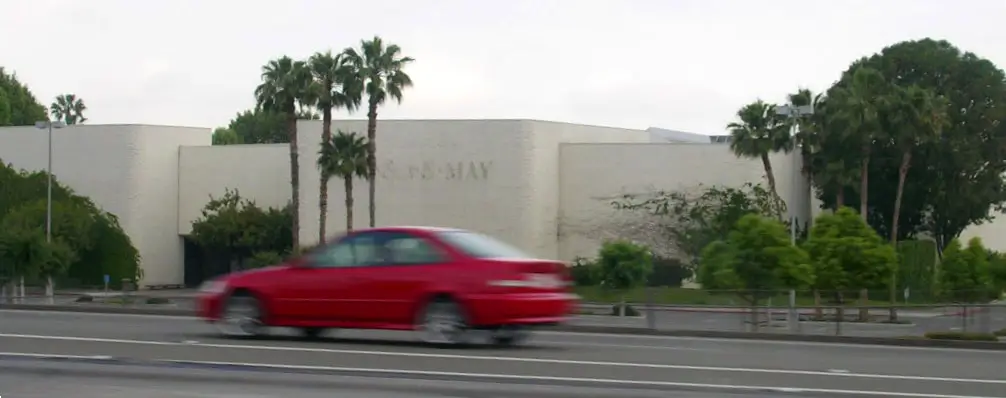
Current Status and New Developments in Galleria at Tyler
In 2023 and 2024, the Galleria at Tyler in Riverside, CA, has seen several exciting new additions and events that continue to enhance its appeal as a premier shopping and dining destination.
On February 2, 2023, Apóla Greek Grill celebrated its grand opening in the food court of the Galleria at Tyler. This was the chain's first location in the Inland Empire. Apóla Greek Grill offered a variety of Mediterranean dishes, including chicken, pork, beef, lamb, and meatless gyro options, along with shrimp skewers, falafel, and feta fries. Unfortunately, the restaurant has already closed.
Silverlake Ramen, a trendy noodle shop, opened its doors at the Galleria at Tyler in August 2023. Located near the AMC Tyler Galleria 16 and Buffalo Wild Wings, Silverlake Ramen offers a diverse menu that includes various ramen bowls with creamy pork or clear chicken stock and proteins like pork, chicken, shrimp, or tofu. The restaurant also serves rice bowls, pork dumplings, Japanese-style fried chicken, and bao buns.
In October 2023, Galleria at Tyler welcomed a new dining experience with the opening of Stagecoach Country Roadhouse. This unique restaurant concept comes from the Orange County-based Wild Thyme Restaurant Group. Stagecoach combines chophouse classics with innovative twists, creating an exclusive dining experience. The menu features a mix of American bistro and barbecue dishes.
On September 9, 2023, the Galleria at Tyler hosted the ReadyRiverside Public Safety Preparedness Expo in the parking lot outside the food court. This free event aimed to educate the community on emergency preparedness and featured activities for the whole family.
Attendees could participate in hands-on CPR training, watch demonstrations by the Community Emergency Response Team, and explore police and fire vehicle displays and equipment demos. The event underscored the importance of community safety and preparedness.
Today, the Galleria at Tyler remains a vibrant shopping destination. Brookfield Properties manages the mall, ensuring it stays modern and appealing. With over 185 stores, it offers a wide variety of shopping options, from Macy's and JCPenney to Forever 21 and Furniture City.
The mall continues to evolve. New stores and restaurants frequently join the lineup, keeping the experience fresh for regular visitors. The recent addition of pop-up shops and seasonal events also adds to the mall's dynamic atmosphere. These changes reflect a commitment to staying relevant in an ever-changing retail landscape.

